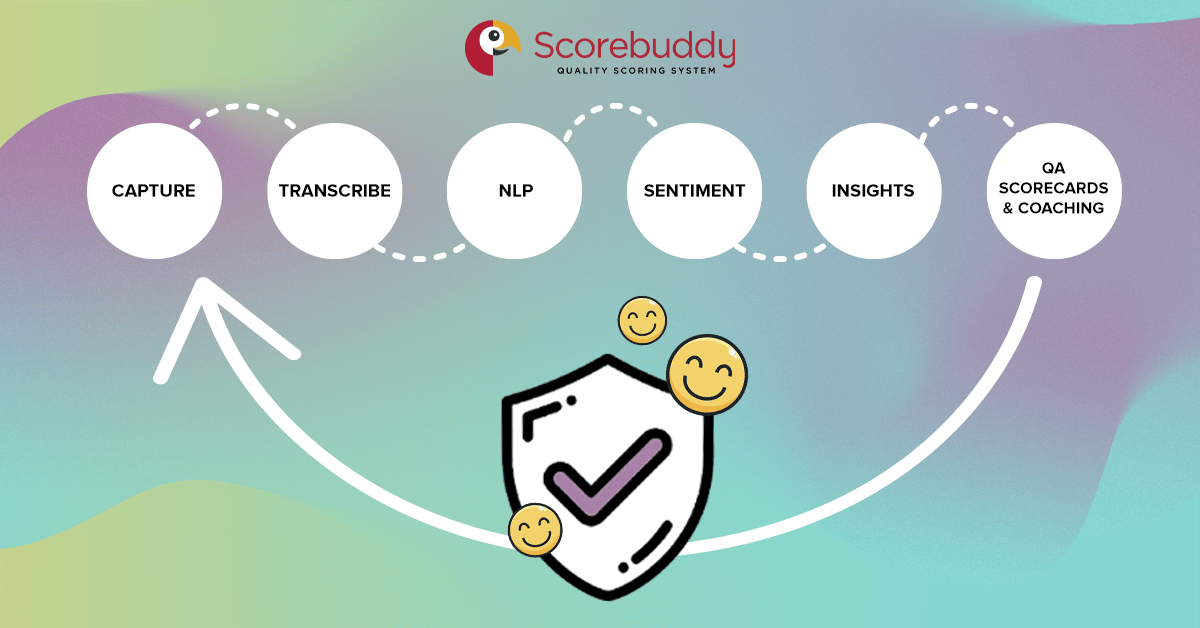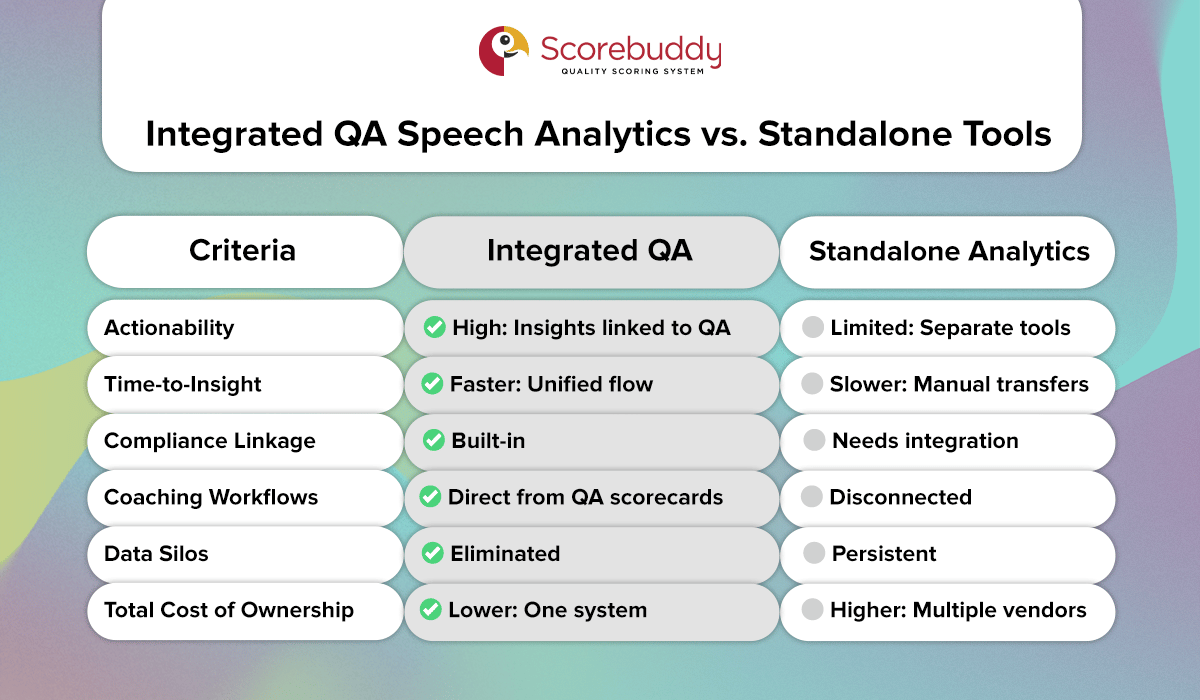Even with the speed and scalability of chatbots and self-service tools, 65% of inbound contact center interactions still occur on voice channels. Every conversation holds valuable clues about customer satisfaction, loyalty, and potential improvement; but too often insights lie buried in unreviewed recordings.
Call center speech analytics unlocks these insights by turning call data into action items for CX leaders.
It enables post-interaction analysis across entire fleets of calls—something manual QA simply can’t do. From spotting compliance risks to detecting customer frustration, it provides a clear overview of what’s happening across thousands, if not hundreds of thousands, interactions.
In this article, we’ll cover what contact center speech analytics software can do, the potential CX impact, and how to integrate with your QA workflow.
Contact center speech analytics is the process of capturing and analyzing customer conversations to uncover insights. These insights then help to improve performance, bolster regulatory compliance adherence, and provide a more enjoyable customer experience. Every call holds this valuable information, and analytics makes raw data actionable.
For QA and CX managers, they can move beyond random call sampling to a scalable system that gives a complete view of customer interactions.
At its core, contact center speech analytics uses artificial intelligence (AI) and natural language processing (NLP) to detect patterns in both the words spoken and the way they are spoken. This gives teams greater insight into customer tone, intent, and emotion, making it much more valuable than just reading a transcript.
Typically, this analysis covers areas like:
You can use these insights to evaluate agent performance at scale, pinpoint areas for coaching, and strengthen compliance monitoring. All without increasing workload. Plus, it gives your team the ability to spot early signals of customer dissatisfaction before they snowball out of control.
Speech analytics transforms everyday interactions into CX intelligence. This provides opportunities for agent coaching, process improvement, and more. By embedding these insights into your QA workflows, you’re creating a data-driven approach to the customer experience.
In most cases, it goes through six stages:

Each stage builds on the last, ensuring nothing gets left behind in the process. By combining speech recognition, machine learning, NLP, and AI, you get a full picture of performance across your team.
AI speech analytics enables large-scale quality monitoring without adding headcount, and reduces the blind spots that come with traditional manual sampling. Most importantly, it ties every insight back to measurable quality outcomes, making it easier to support agents and improve the overall customer experience.
Uncover the root causes of customer churn faster.
By capturing both what customers say and how they say it, businesses can address challenges that might otherwise go unnoticed.
Every call becomes an opportunity to evaluate how agents follow scripts, handle objections, and guide customers to resolution. Instead of listening to a handful of recordings, managers can assess performance across hundreds (or thousands) of interactions automatically.
Regulatory requirements, disclosures, and legal scripts can be monitored at scale. Speech analytics raises flags when mandatory statements get missed or misconstrued, helping reduce compliance risks and protecting your business from fines and legal troubles.
Calls carry emotional cues that show satisfaction, frustration, and a whole host of feelings that you likely won’t catch in a text transcript. By detecting tone, stress, or repeated negative phrases, managers can see where service is falling short and take action before it spirals.
AI analytics highlight specific phrases or behaviors that separate top-performing agents from the rest. This makes it easier to design targeted coaching programs that boost skills and confidence across the team. You’ll know exactly how to replicate the behaviors of your top performers.
Recurring keywords or spikes in call topics can uncover product issues, billing errors, or policy confusion. These insights allow leaders to find, intervene, and resolve the root causes of these issues and prevent them from happening again.
By surfacing common reasons for calls, call center voice analytics can guide workflow adjustments, self-service updates, or knowledge base improvements that reduce handle times and improve first-call resolution.
Many contact centers adopt analytics tools that operate independently from their QA process. While these solutions do capture valuable data, they often leave managers juggling multiple platforms and piecing together fragmented reports.
The result: siloed data that makes it harder to get a full picture of customer interactions.
Another challenge is the added manual effort required to link these analytics to QA reviews. Managers have to export results, match them to individual calls, and then assign follow-up tasks all separately. This slows down workflows and reduces the value of analytics, because insights remain disconnected from the quality management cycle.
Even when standalone analytics highlight customer feedback, sentiment, or recurring issues, they often fall short in delivering actionable next steps. Without a direct tie to agent scorecards or coaching frameworks, the data remains abstract.
You’re left knowing what the problem is, but not how to start fixing it.

Integrating speech analytics directly into QA eliminates these roadblocks. When insights automatically flow into the evaluation process, managers can assess agent performance with a blend of quantitative and qualitative data.
Calls that trigger sentiment flags or missed compliance phrases are linked to performance metrics, giving every review a stronger foundation.
This integration also enables faster coaching and feedback. Supervisors can see not only what was said on a call, but also how it affected customer sentiment and overall quality scores. Coaching becomes more targeted, timely, and measurable, which builds trust between managers and agents.
Compliance benefits in the same way. Instead of being a separate audit step, regulatory monitoring becomes part of everyday QA. Disclosures, scripts, and required language are all captured in the same workflow, reducing risks while saving you hours of review time.
Together, speech analytics call center software and QA software drive efficiency, accuracy, and accountability.
|
Feature / Aspect |
Integrated QA Speech Analytics |
Standalone Speech Analytics Tools |
|
Platform Connection |
Unified within the QA platform. Analytics and evaluations occur in the same system. |
Operates separately from QA, requiring managers to juggle multiple platforms. |
|
Data Flow |
Insights automatically flow into the QA process, linking analytics directly to evaluations. |
Data remains siloed; requires manual exports and imports to connect analytics with QA. |
|
Workflow Efficiency |
Streamlined. Reduces manual QA effort and speeds up performance reviews. |
Fragmented. QA managers spend extra time matching analytics to individual calls. |
|
Actionability of Insights |
Directly tied to agent scorecards and coaching tools, enabling targeted action. |
Generates insights but lacks connection to coaching or agent performance frameworks. |
|
Coaching & Feedback |
Enables real-time, data-driven coaching that’s measurable and timely. |
Feedback loop is slower and less focused since analytics aren’t tied to QA reviews. |
|
Compliance & Risk Management |
Integrated monitoring of scripts and disclosures within the QA workflow. |
Compliance must be handled as a separate process, increasing review time. |
|
Reporting & Visibility |
Provides a unified view of performance, sentiment, and quality metrics. |
Reports are fragmented across platforms, limiting holistic visibility into the call center. |
|
Efficiency |
Reviews more calls with less effort, leveraging automation. |
More manual steps lead to slower review cycles. |
|
Accuracy |
Analytics linked to specific agents and interactions, improving precision. |
Insights often limited to broad trends, reducing individual accountability. |
|
Accountability |
Shared visibility between managers and agents builds trust and ownership. |
Disconnected data makes it harder to tie insights to performance outcomes. |
|
Overall Impact |
Drives efficiency, accuracy, and accountability across QA and compliance. |
Delivers insights but lacks integration to turn them into measurable improvements. |
Implementing contact center speech analytics in a QA program is most effective when you have the right strategy.
Of course, before you roll out your speech analytics program, you’ll need to ensure that all the important foundational elements are in place. Here’s a checklist to make sure you’ve covered the essentials.
Speech analytics transforms customer conversations into CX intelligence that drives measurable improvements. By recording, transcribing, and analyzing calls, it gives QA and CX managers visibility into both customer sentiment and agent performance. Instead of relying on random samples, teams can evaluate interactions at scale with accuracy and speed.
The impact is clear across the contact center:
Managers can identify patterns, address issues early, and tie every review back to meaningful quality outcomes.
When integrated as part of your QA workflows, speech analytics creates a seamless loop between data and action. Scorecards, tailored coaching, and ongoing compliance monitoring keep teams accountable and efficient.
With Scorebuddy, you get a single platform that combines conversational analytics with quality assurance. This turns every conversation into an opportunity for better service and stronger customer experience.
Get a demo of Scorebuddy’s conversational analytics and see the power of merging QA + speech analytics.
What’s the difference between post-call and real-time speech analytics?
Post-call and real-time speech analytics are related, but separate, functions for improving overall contact center performance. Let’s look at the differences:
-Post-call: Processes recordings after an interaction has ended. This is useful for QA teams who want to analyze CX trends, spot compliance issues, and inform agent coaching without disrupting live support operations.
-Real-time: As you might expect, works during live calls to detect sentiment, keywords, and risks in the moment.
In most cases, contact centers will start with post-call analytics as this requires less infrastructure and resources to scale effectively and can provide a significant ROI in terms of CX and agent performance improvements.
How does data retention and redaction work in speech analytics call center systems?
In most cases, analytics tools will align retention policies with organizational data governance and regulatory standards like GDPR, PCI-DSS, HIPAA, etc.
Key practices for data protection and redaction include:
-Configurable retention windows for call audio, transcripts, and metadata
-Automatic redaction of sensitive data (credit card numbers, personal identifiers)
-Access controls and encryption to protect data both in transit and at rest.
Before deployment, you should make sure the retention durations and anonymization settings align with your specific compliance requirements.
How do I integrate speech analytics with my contact center QA platform?
There are a few different pathways to integration.
Native connectors offer a direct integration with your QA, CRM, or call recording platform (solutions like Scorebuddy, Salesforce, Genesys, and so forth).
There’s also the possibility of APIs for custom connections, so you can support real-time data exchange and workflow automation.
For those looking to blend speech data with business intelligence or reporting tools, you’ve got the option of data exports using CSV, JSON, or secure FTP.
Ultimately, it comes down to your own IT environment, data privacy needs, and the level of automation you’re looking for in the QA process.
What’s the benchmark for transcription accuracy and what affects it?
The benchmark can vary significantly depending on a range of factors, which we’ll examine below, but, generally speaking, most speech analytics platforms achieve 80 to 95% transcription accuracy.
As noted, this is influenced by factors like:
-Audio quality: Background noise, multiple speakers, or poor connections can reduce accuracy
-Accent and language diversity: Regional variations or multilingual environments may require model tuning
-Vocabulary specificity: Industry terms, product names, or abbreviations may need custom language models
With regular calibration and human-in-the-loop reviews, you may be able to improve accuracy over time. Or, at least, maintain it.